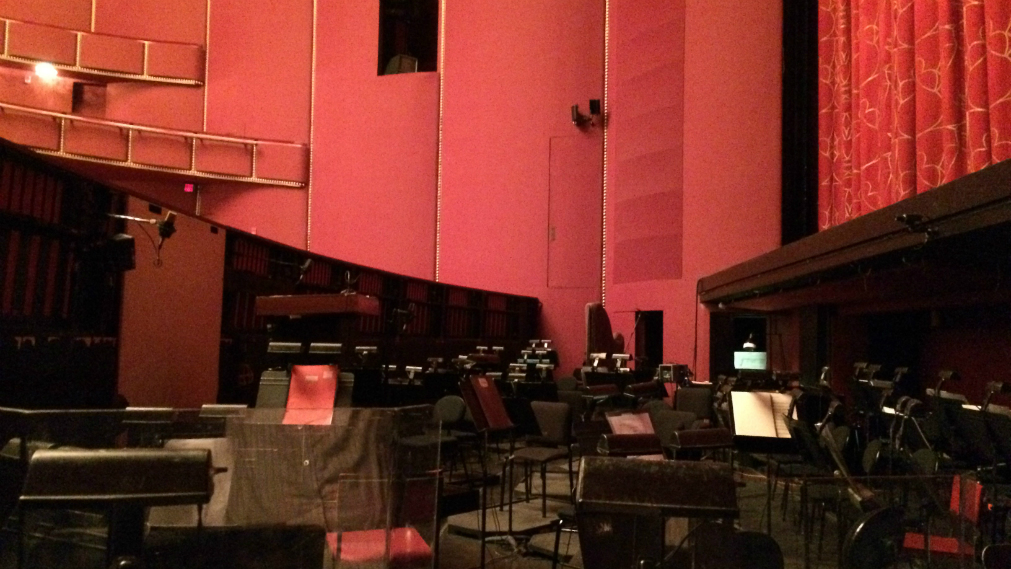When I tell folks that I’m a member of a pit orchestra, they are often intrigued. What’s it like to play music down there? Can you see what’s happening onstage? How often do you perform?
So, I thought it would be worthwhile to go in depth about what it’s like in the depths of the Kennedy Center’s theaters, where we perform opera, ballet, musical theater, and any other staged performances that call for live music.
First, here are some basics that I’ve learned so far in my first three and a half seasons.
- During an opera, if I can’t hear the singers, then I am definitely playing too loud.
- Typically, some orchestra members are able to see the stage from their seats. If I happen to be one of those people, it can admittedly be very tempting to drift my eyes away from our task at hand. As a trombonist, I often have long periods of time in which I don’t play, so I will only allow myself to look towards the stage if I know the music so well that I won’t become distracted and miss an entrance.
- During the rehearsal process of an opera, there will be at least one Piano Dress Rehearsal. This is a run-through in which a staff pianist will use his/her ten fingers to provide the music that will be played by the entire orchestra. First of all, attending this is an incredible sight to behold; the Washington National Opera has some phenomenal pianists on staff. Moreover, it’s an opportunity to sit out in the audience and learn what is happening onstage. This helps me understand my role during any given moment of the opera.
- We sit for long periods at a time, sometimes as long as two and a half hours without intermission. There are a variety of ways to avoid neck, shoulder, or back pain from bad posture. Yoga and Alexander Technique are my two methods of choice, and I find that when I’m in the habit of doing either of these regularly, my posture is much better.
- To keep improving the nuts and bolts of trombone playing, the music I practice at home has to compliment what we are currently playing in the orchestra. (Forgive the mumbo jumbo for just a moment.) For example, we did Rossini’s “La Cenerentola” for almost an entire month. As is common in this corner of the repertoire, my part demanded lots of articulation in the middle register at a soft dynamic. So, it was important that I practice long-lasting, lyrical music at all dynamics and ranges. This way, I was addressing a diversity of fundamentals in my playing throughout that month.
There are also broader aspects about this job that have made quite an impact on my life.
- There is a good variety of repertoire in the Kennedy Center Opera House Orchestra, and I love it. This didn’t completely occur to me until my third season, when we performed “The Rite of Spring,” “The Flying Dutchman”, and “The Book of Mormon” all within a six-month period.
- Before joining the orchestra, I had been a member of the New World Symphony, where the performance schedule often follows a typical symphony orchestra’s: Daytime rehearsals Tuesday-Thursday, Evening performances Thursday-Saturday, and perhaps a Sunday matinee. In contrast, while we do have some daytime rehearsals, most of our time at work occurs on weeknights and weekends.This switch has become a double-edged sword for me. On one hand, it has been a challenge to foster friendships with people whose work-lives exist Monday through Friday, 9 to 5. I’ve missed out on a fair number of get-togethers and weekend events. But on the other hand, I’ve had more time during the day to cultivate different facets of my career. I teach music lessons, and I serve on the Executive Board of the Musicians Union, the DC Federation of Musicians (Local 161-710). Taking care of errands is usually never a problem, and neither is needing to be home during a three-hour window of time so that the electrician can try yet again to fix that god-awful washing machine.
- Working in an opera house has completely opened my eyes to the different moving parts of staged performances. Beyond the people onstage and in the orchestra pit, there is a whole world of rehearsal conductors, rehearsal pianists, vocal coaches, stage hands, stage managers, wardrobe dressers, costume stylists, wig masters …it’s incredible. Some of them are often the first faces that greet me as I enter the backstage area. I make sure to chat with these people whenever I can because I love learning about what they do. They are excellent at it, and their stories are fascinating.
In addition to these discoveries, I’d also like to share this video featuring the Musicians of the Chicago Lyric Opera Orchestra. It’s an excellent, four-minute window into the moments leading up to a performance, and the musicians who are interviewed offer some interesting tidbits. Of course, my favorite quote is given by Concertmaster Robert Hanford: “Pit people are good people.”
Subscribe via Email
Enter your email address to subscribe and receive notifications of new posts on the first Monday of each month by email.



I love this, Doug! Thanks for giving us a glimpse into your world!
I’m so glad you like it, Alisha!!